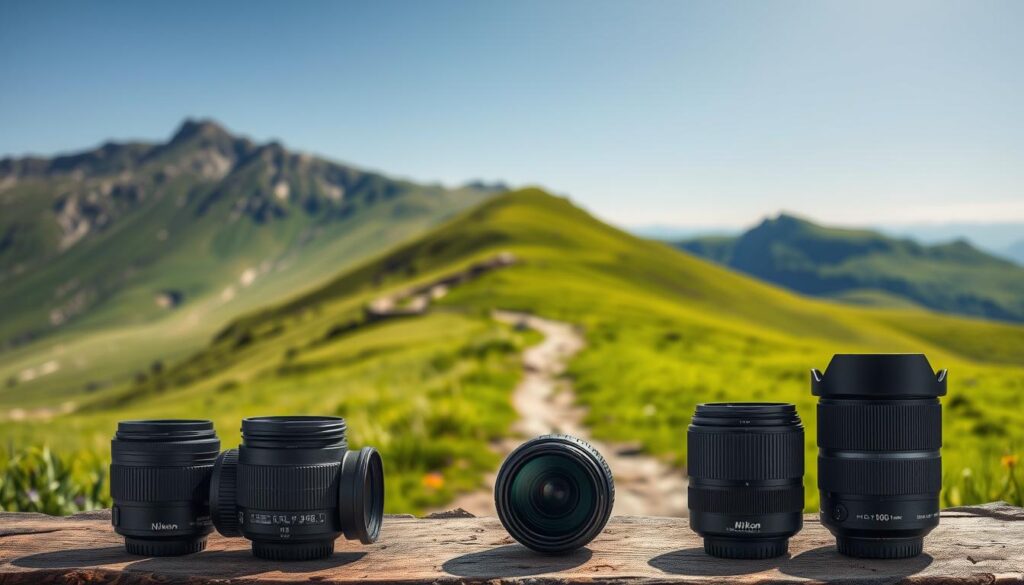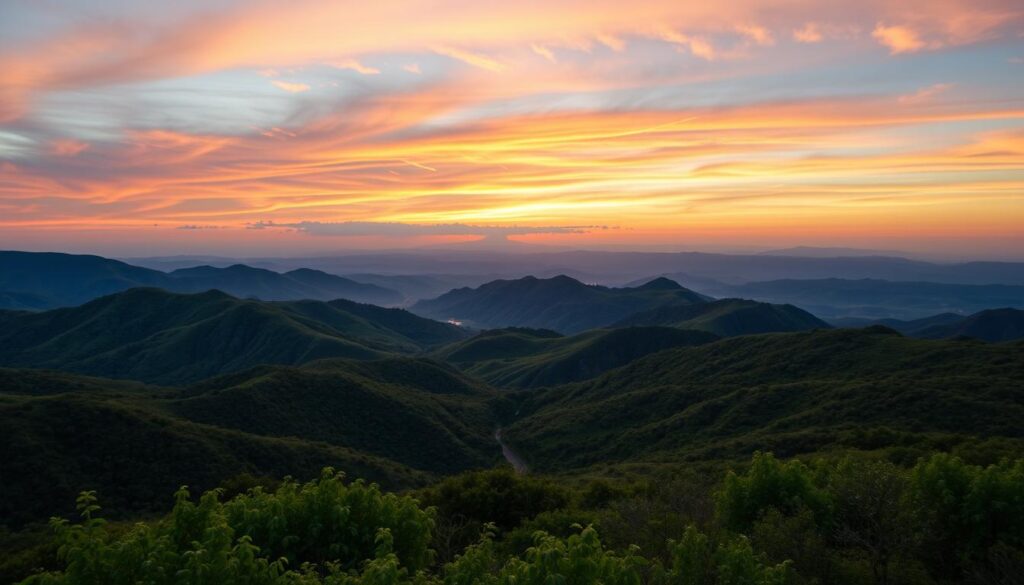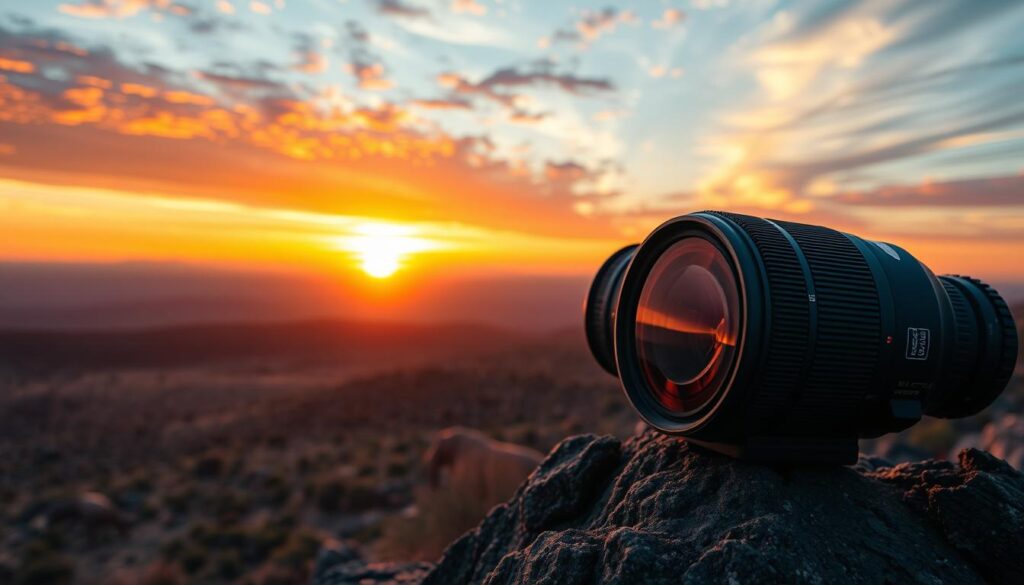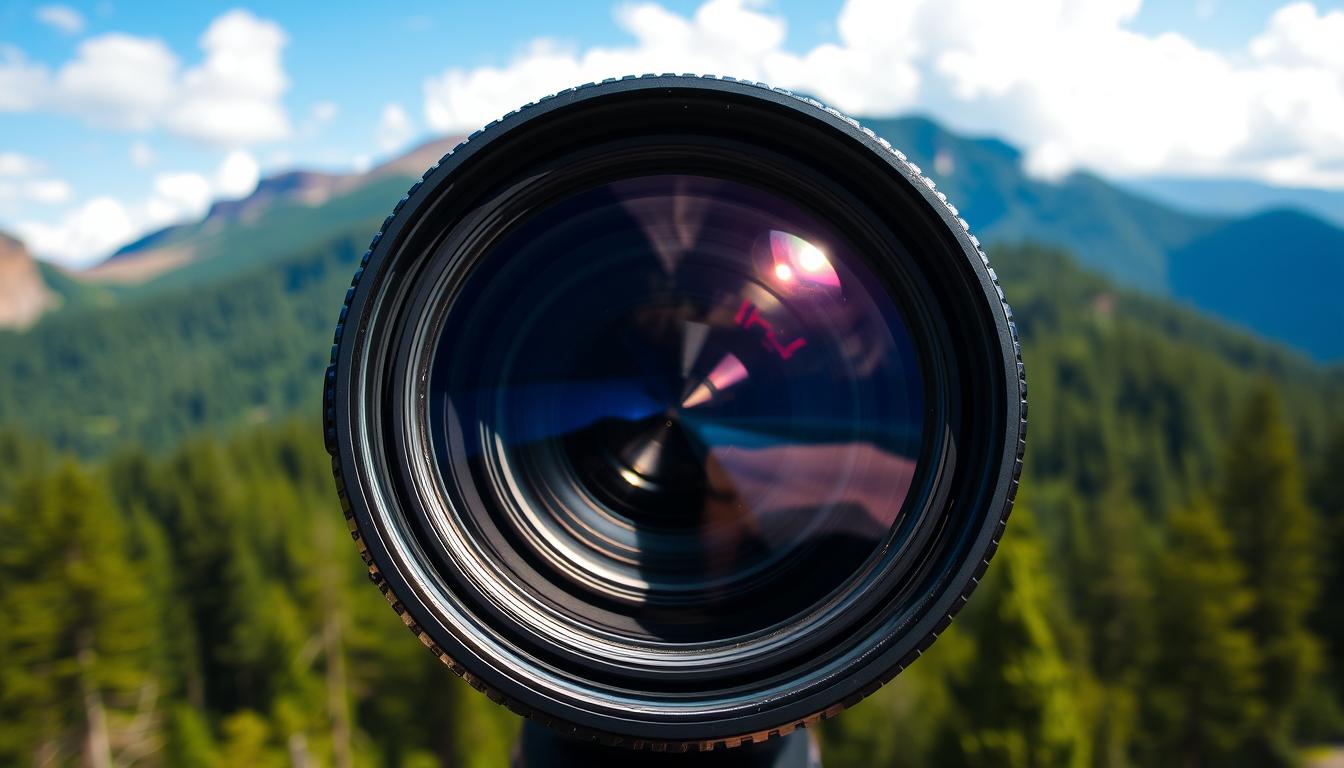Introduction
For stunning landscapes, a top-notch nikon outdoor lens is key. It helps you get professional-grade photos. The right lens can also add unique effects, showing off nature’s beauty.
A great nikon outdoor lens changes your outdoor photos. It lets you easily capture wide landscapes or small nature details. This lens helps you bring your creative vision to life.
Getting a high-quality nikon outdoor lens boosts your outdoor photography. It gives you the tools for amazing images that inspire. With this lens, you can explore new creative paths and expand your art.
Nikon Outdoor Lenses
In outdoor photography, a good nikon outdoor lens is vital. With many choices, picking the right one can be tough. But knowing what each lens offers helps you choose wisely and improve your photos.
Key Takeaways
- Investing in a high-quality nikon outdoor lens can enhance the quality of your photographs
- A nikon lens for outdoor photography can help you achieve unique effects and showcase the beauty of the natural world
- Understanding the key features and benefits of different lenses can help you make an informed decision
- A good nikon outdoor lens can make all the difference in your outdoor photography
- With a nikon lens for outdoor photography, you can unlock new creative possibilities and push the boundaries of your art
- A nikon outdoor lens is a critical tool for capturing stunning landscapes
Understanding Nikon Outdoor Lens Basics
For amazing outdoor shots, the right lens is key. The best Nikon lens for outdoor shots can greatly improve your photos. To pick the top Nikon outdoor lenses, you must know what makes a lens good for outdoor photography.
Lenses for outdoor photography need to handle different weather. Weather sealing and durability are key when choosing a lens. A well-sealed lens protects your camera from dust, moisture, and damage.
Key Features of Outdoor Photography Lenses
Look for focal length, aperture, and image stabilization in outdoor lenses. The focal length affects your photo’s angle and compression. For wide landscapes, a 10-24mm lens is perfect.

Weather Sealing and Durability Factors
Weather sealing and durability are vital for outdoor lenses. A sealed lens can handle rain, snow, and extreme temperatures. Choose lenses with a strong build and weather-sealing features like rubber gaskets.
Focal Length Considerations for Outdoor Shooting
The focal length is important for outdoor photography. Different lengths are best for different shots. Wide-angle lenses (10-24mm) are great for landscapes, while telephoto lenses (70-200mm) are better for distant subjects.
Essential Nikon Lens Categories for Outdoor Photography
For amazing outdoor photos, the right nikon lens for outdoor adventures is key. Nikon has many lenses made for outdoor shots, including nikon lens for landscape photography. These lenses can handle tough weather and give top-notch photos.
Nikon lenses for outdoor photos come in three main types: wide-angle, telephoto, and versatile. Each type has special features and benefits. Wide-angle lenses are great for big landscapes. Telephoto lenses are best for far-off details.

When picking a nikon lens for landscape photography, think about what you’ll shoot most. For wide views, a wide-angle lens is best. For close-up shots, a telephoto lens works better. The best lens depends on your style and what you like to shoot.
Some top picks for nikon lens for outdoor adventures are:
- Wide-angle lenses, such as the Nikon 14-24mm f/2.8
- Telephoto lenses, such as the Nikon 70-200mm f/2.8
- Versatile lenses, such as the Nikon 24-120mm f/4
Wide-Angle Wonders: Perfect for Vast Landscapes
Wide-angle lenses are great for capturing big landscapes. They let you see more of the scene in your shot. If you want to buy nikon outdoor lens for landscapes, look into wide-angle options. Check out a nikon outdoor lens review to pick the right one.
Wide-angle lenses are either prime or zoom. Prime lenses have a fixed length, while zoom lenses adjust. Prime lenses are sharper and smaller, but zoom lenses are more flexible.
Here are some things to think about when picking a wide-angle lens:
- Focal length: A shorter focal length means a wider view.
- Aperture: A bigger aperture lets in more light.
- Image stabilization: This helps reduce camera shake and blur.
When choosing a wide-angle lens, think about your budget. Also, read a nikon outdoor lens review to find the best one for you. Some top picks include the Nikon 14-24mm f/2.8 and the Nikon 20mm f/1.8.

| Lens Model | Focal Length | Aperture | Price |
|---|---|---|---|
| Nikon 14-24mm f/2.8 | 14-24mm | f/2.8 | $1,800 |
| Nikon 20mm f/1.8 | 20mm | f/1.8 | $900 |
Telephoto Masters: Capturing Distant Details
A nikon lens for wildlife photography is key for capturing distant details outdoors. These lenses let photographers get close to subjects without scaring them off. This way, you can get high-quality images of wildlife from a safe distance.
Using a telephoto lens for wildlife photography has many benefits. Here are a few:
- It lets you take photos from far away, without bothering the subject.
- It produces images with great detail and clarity.
- It works well in different lighting conditions.
A nikon lens for wildlife photography is also great for landscapes and portraits. It can make scenes look deeper and more interesting. This adds a new level to your outdoor photos.

In summary, a nikon lens for wildlife photography is a must-have for outdoor photographers. It helps capture distant details and creates amazing images. It’s a key tool for anyone wanting to improve their photography skills.
Versatile All-in-One Nikon Outdoor Lens Solutions
Outdoor photography benefits greatly from a versatile lens. A nikon outdoor lens that can do it all, from wide landscapes to close-ups, is key. We’ll look at the advantages of a nikon lens for outdoor photography that can handle many tasks.
Travel-friendly nikon outdoor lenses are a must for photographers always on the move. These lenses are small and light, making them simple to carry. The Nikon 24-120mm f/4G ED VR and the Nikon 24-70mm f/2.8G ED are great examples.
Travel-Friendly Options
- Nikon 24-120mm f/4G ED VR
- Nikon 24-70mm f/2.8G ED
There are also professional-grade versatile lenses for those who need top-notch quality. The Nikon 28-300mm f/3.5-5.6G ED VR is a favorite among pros.
Professional-Grade Versatile Lenses
For those watching their budget, there are affordable nikon lens options. These lenses might not have all the bells and whistles, but they offer great quality and versatility. The Nikon 18-140mm f/3.5-5.6G ED VR and the Nikon 18-200mm f/3.5-5.6G ED VR are worth considering.
Budget-Conscious Choices
Finding the right nikon outdoor lens depends on your needs and budget. By exploring the options mentioned, you can find a versatile lens that fits your needs and helps you take amazing outdoor photos.
Mastering Technical Aspects of Outdoor Lens Usage
Understanding your Nikon lens is key for amazing outdoor shots. The right lens can greatly improve your photos. To use your Nikon lenses to their fullest, learn the technical side.
Aperture settings are a big deal. It’s the lens opening size, affecting how much light gets in. For landscapes, a small aperture (high f-stop number) is best. It keeps more of the scene in focus.
Aperture Settings for Landscape Photography
For landscapes, f/11 or f/16 works well. It makes sure everything is sharp. But, it might need a longer shutter time, which can be tough in bright light. A big aperture, like f/2.8 or f/4, is better for portraits or close-ups. It blurs the background.
Focus Techniques for Sharp Images
Sharp images need the right focus. Autofocus is quick and accurate. But, manual focus gives you more control. With the best Nikon lens and these techniques, your outdoor photos will be stunning.
Mastering these technical aspects will elevate your outdoor photography. You’ll take breathtaking shots with your Nikon lenses.
| Aperture Setting | Depth of Field | Exposure Time |
|---|---|---|
| Small (f/11 or f/16) | Large | Longer |
| Large (f/2.8 or f/4) | Shallow | Shorter |
Weather Protection and Maintenance Tips
When using a nikon lens for outdoor adventures, protecting it from the weather is key. This helps it last longer and keeps your photos sharp. Weather protection and regular care are essential to avoid damage.
To keep your lens safe, try these tips:
- Use a lens hood to shield the lens from rain and snow
- Apply a waterproof coating to the lens
- Store the lens in a dry, cool place when not in use
Regular upkeep is also important for your nikon lens for outdoor adventures. Clean it with a soft cloth and avoid extreme temperatures.
By following these tips, your nikon lens for outdoor adventures will stay in top shape. This means you’ll get great photos for many years.
| Maintenance Tip | Frequency |
|---|---|
| Clean the lens | After each use |
| Check the lens for damage | Monthly |
| Store the lens in a dry place | Always |
Choosing the Right Filters for Your Outdoor Lens
Choosing the right filters is key to capturing stunning outdoor images with your Nikon outdoor lens. Whether you’re buying a Nikon outdoor lens or already have one, knowing about different filters can enhance your photography. A good nikon outdoor lens review will often talk about how filters improve image quality.
Filters can reduce glare, enhance colors, and protect your lens. For example, polarizing filters are great for reducing reflections and making colors pop. If you’re getting a Nikon outdoor lens, a polarizing filter is a must-have.
Polarizing Filters for Enhanced Colors
Polarizing filters filter out light waves, making colors richer and more vibrant. They’re perfect for landscapes, skies, and water. They reduce glare and enhance colors.
ND Filters for Long Exposures
Neutral density (ND) filters let less light in, allowing for longer exposures. They’re great for capturing moving subjects like water or clouds.
UV Filters for Lens Protection
UV filters protect your lens from ultraviolet light damage. They reduce haze and improve image clarity. They’re a smart investment for outdoor photographers.
In conclusion, the right filters can greatly improve your outdoor photography. Knowing about polarizing, ND, and UV filters helps you choose the best accessories. Always read a nikon outdoor lens review to understand the lens and its capabilities.
| Filter Type | Description | Benefits |
|---|---|---|
| Polarizing Filter | Reduces glare and enhances colors | Richer, more vibrant colors |
| ND Filter | Reduces light for longer exposures | Creates sense of motion, captures flowing water and clouds |
| UV Filter | Protects lens from UV light damage | Reduces haze, improves image clarity |
Investment Considerations and Price Ranges
When you’re looking to buy a nikon outdoor lens for outdoor photos, think about the cost. The price of a nikon lens for outdoor photography changes a lot. It depends on the lens type, quality, and brand.
Here are some key factors to consider when investing in a nikon outdoor lens:
- Entry-level options: $200-$500
- Mid-range options: $500-$1,200
- High-end options: $1,200-$2,500
- Professional-grade options: $2,500-$5,000
Think about your budget and what you need for your photos. This helps you choose the right nikon lens for outdoor photography. You’ll find the perfect nikon outdoor lens for your needs.
In conclusion, picking a nikon outdoor lens needs careful thought about prices and what you need. Knowing the different options and their prices helps you make a good choice. You’ll find the perfect nikon lens for outdoor photography to improve your photos.
| Price Range | Lens Type | Features |
|---|---|---|
| $200-$500 | Entry-level | Basic features, suitable for casual photography |
| $500-$1,200 | Mid-range | Advanced features, suitable for enthusiast photographers |
| $1,200-$2,500 | High-end | Professional-grade features, suitable for professional photographers |
| $2,500-$5,000 | Professional-grade | Top-of-the-line features, suitable for expert photographers |
Common Mistakes to Avoid with Outdoor Lenses
When using the best Nikon lens for outdoor shots, knowing common mistakes is key. These mistakes can harm your photos and equipment. Understanding and avoiding these errors will help you get the most from your Nikon lenses.
Some common mistakes include storing your lens in extreme temperatures or humidity. Not using a protective case when you transport it is another error. Also, using the wrong aperture or shutter speed can ruin your photos. Being aware of these mistakes will help you take better photos and keep your gear in top shape.
- Always store your lens in a cool, dry place, away from direct sunlight.
- Use a high-quality protective case when transporting your lens.
- Familiarize yourself with your lens’s technical settings and practice using them before heading out on a shoot.
By following these tips and using the best Nikon lens for outdoor shots, you can take amazing photos. Enjoy a successful outdoor photography experience with your top Nikon outdoor lenses.
| Mistake | Consequence | Solution |
|---|---|---|
| Improper storage | Damaged equipment | Store in a cool, dry place |
| Poor transportation | Damage during transport | Use a protective case |
| Technical usage mistakes | Subpar images | Familiarize yourself with settings |
Conclusion
Starting your outdoor photography journey with Nikon lenses is exciting. The secret to amazing shots is knowing each lens’s strengths. This guide has helped you pick the right lens and learn outdoor photography skills.
Nikon’s lenses are perfect for landscapes, wildlife, and nature. They offer top-notch image quality and flexibility. With the right lenses, you’ll see your outdoor adventures in a new light.
Keep exploring with Nikon’s lenses and try new things. The outdoors is full of beauty waiting to be captured. With the right gear and skill, your photos will show the true beauty of your adventures.
FAQ
What are the key features to look for in a Nikon outdoor lens?
When picking a Nikon outdoor lens, look for weather sealing and durability. Also, choose a focal length that fits your photography needs. This could be for landscapes, wildlife, or adventure shots.
How do I choose the best Nikon lens for outdoor photography?
The right Nikon lens for outdoor photos depends on your needs. Wide-angle lenses are perfect for big landscapes. Telephoto lenses are great for close-up shots of wildlife. All-in-one lenses are versatile for outdoor adventures.
What are the benefits of using a wide-angle lens for landscape photography?
Wide-angle lenses are ideal for landscapes. They let you capture vast scenes and expansive skies. They add depth and show the scale of the surroundings.
How can a telephoto lens be useful for outdoor photography?
Telephoto lenses are great for wildlife photos. They let you get close shots without disturbing animals. They also create unique views in landscape photos by compressing perspective.
What are some tips for maintaining and protecting my Nikon outdoor lens?
To keep your Nikon lens in top shape, clean it often and store it right. Use UV filters for extra protection. Handling it carefully and watching the weather can also help it last longer.
How can I choose the right filters for my Nikon outdoor lens?
Choose filters based on your shooting needs and desired effects. Polarizing filters can improve colors, ND filters are for long exposures, and UV filters protect your lens. Think about what you need for your photos.
What are some common mistakes to avoid when using Nikon outdoor lenses?
Avoid common mistakes like bad storage and using your lens wrong. Don’t forget to adjust aperture and focus for outdoor conditions. This will help you get better photos.
